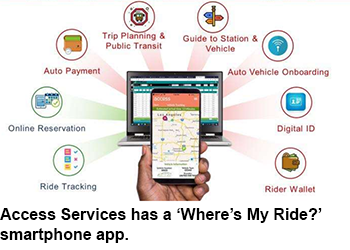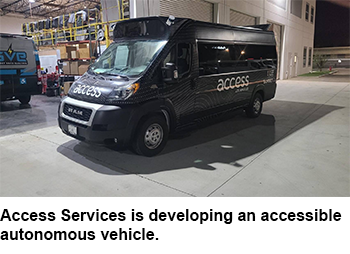Digital Innovations to Make Paratransit More Accessible
By Jacob Herson
Managing Editor
Transit California
“Serving passengers with physical, cognitive, and developmental disabilities in a fair and equitable way is the core of the Americans with Disabilities Act (ADA),” explains Tiffani Fink, CEO of Paratransit, Inc., a private paratransit services provider in the Sacramento region. “In the early days of the ADA, this was easily translated to mean lift-equipped vehicles and complementary paratransit service.” The ADA requires any agency providing fixed-route service to provide complementary paratransit service.
“But as society evolves, so does the process to reach, educate, and assist these passengers,” says Fink. “While the ADA offers a complement in traditional ADA paratransit, it does not provide the user with the same freedom of travel that fixed-route and rail does, namely due to its day-prior service.” Riders must book their rides a day in advance. “While services such as on-demand transit assist in closing this gap, the longer-term solution is in assistive technologies that allow these passengers to travel along fixed-route and rail corridors, with technological assistance,” says Fink.
“The topic of assistive technologies has been the main focus of agencies from Caltrans to the federal Department of Transportation (DOT), with the latter creating the Accessible Transportation Technologies Research Initiative. While agencies have historically succeeded in travel instruction, this program is researching ways to integrate technology into the long-term solution. By establishing ‘wayfinding’ patterns, it has shown that passengers increase success in navigating on their own. The initial study developed a platform for families to upload images and other visual clues to assist the passenger while out on the system.
“Outside of the government research space, apps are starting to appear that offer a range of assistance, from system navigation, to audible visualization of one’s surroundings for those who are visually impaired. While each offers additional accessibility, challenges with internet/cell reception and coverage limit their resourcefulness for most Californians,” says Fink.
Access Services is at the forefront of developing some of these digital innovations. The agency is responsible for providing coordinated complementary ADA paratransit services for all fixed-route transit agencies across Los Angeles County, making it, by budget, one of the largest paratransit agencies in the United States.
Executive Director Andre Colaiace explains: “We have a smartphone app called ‘Where’s My Ride?’ (WMR). It’s becoming our all-in-one application to do all sorts of different functions with the service. Its main function thus far has been to allow our customers to track their vehicle arrival time.” However, aided by a $330,000 federal grant, the agency is working to expand the functionality of WMR to address other challenges, such as missed rides.
“One of the issues we have is when a driver tries to find a customer in a large complex, like Staples Center, or a big hospital,” says Colaiace. “Sometimes it’s difficult for them to know where to find each other, particularly if a customer has a visual impairment. We’ve implemented all sorts of things, like stand signs, to help our drivers and customers; even then they’ll sometimes miss each other. So we’re also implementing a rider-to-driver communication system.” The app enables the rider and driver to communicate with one another and also shows the driver on a map where the rider is located.
Access Services is also testing Bluetooth beacons that would alert both the driver and customer when the driver has arrived at the correct location. These beacons could also enable the visually impaired to navigate within facilities using voice guidance from their smartphone. LA Metro has implemented something similar at Union Station. Bill Tsuei, Access Services Director of Information Technology explains, “Our technology is different from what Metro implemented at Union Station. Metro is using a barcode to provide turn-by-turn guidance. People have to scan the barcode to know where they are and then try to go where they want to be. In our case, there’s no scanning required. You just download the app. It will detect where you are and then try to find the map for that particular location. Then it will ask you where you want to go and provide turn-by-turn guidance.”
Access Services has also built an accessible autonomous vehicle, the first in the U.S. that satisfies all four necessary requirements: the ADA, Federal Motor Vehicle Safety Standards (FMVSS), Altoona crash test regulations, and Buy America requirements. Built with the help of a $120,000 federal grant, the vehicle was completed in October 2021 and is scheduled to undergo a closed-environment, SAE Level-four (driver in the vehicle but not actively driving) test at the LA Convention Center in September 2022.
“When everyone’s talking about autonomous vehicles, they never talk about accessibility,” says Colaiace. “Usually people with disabilities are the last to get these types of technologies, so we wanted to be at the forefront of this. As this technology was being developed, Bill and his team wanted to make sure that we would try and develop our own accessible vehicle that also had autonomous technologies.”
Tsuei says, “Several other agencies are looking at our solution. We’re assisting RTC (Regional Transportation Commission of Southern Nevada) in Las Vegas and are in conversations with the City of San Jose. They want to implement this technology for the circulator route connecting San Jose International Airport with downtown San Jose. They like the vehicle design we have, so they are in talks with our technology solution provider.”
Colaiace says, “Ultimately, in what we do, we don’t think that we would ever have a vehicle that wouldn’t have a person on it, given who we transport. But in theory, if you don’t need to have an active driver, they can focus on being there to assist the customer.”
“Innovation in autonomous vehicles is advancing rapidly,” says Colaiace. “Cruise in San Francisco is already deploying its fleet. But those vehicles aren’t accessible. So what if we start doing some of the experimenting so autonomous vehicles can be accessible to everyone.”
Finks believes: “While these technologies and studies will continue to provide enhancements, we must continue focusing on the fact that we provide public transportation and that any key to success relies on ensuring the human element of these services. While dynamic technologies will assist, maintaining well-staffed call centers and customer service offices, offering sensitivity training to our operators and system attendants, and actively engaging these communities are the easiest way to offer sustained system enhancement and accessibility.”